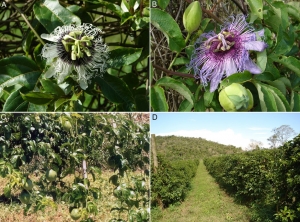Passiflora BAC library construction

In collaboration with:
-
Dr. Maria Lucia Carneiro Vieira
Professora Titular do Departamento de Genética Escola Superior de Agricultura "Luiz de Queiroz"
Universidade de São Paulo
Caixa Postal, 83
13400-970 Piracicaba, Brasil
Phone: 55 19 3429 4442
E-mail: mlcvieir@esalq.usp.br
-
Helen Alves Penha
Doutoranda em Genética e Melhoramento de Plantas
Departamento de Genética
Lab. de Biologia Celular e Molecular de Plantas
Universidade de São Paulo - USP-ESALQ
Phone: (19) 34294442
Website : http://www.esalq.usp.br/
Abstract
Passiflorae ( Passifloraceae) is a large and widespread genus consisting primarily of tropical flora. Many Passiflora are cultivated as ornamentals and for their edible fruits or medicinal properties. The demand of aromatic passion fruit juice in the European and American market is very encouraging to South American producers. Then, the selection of varieties that combine high productivity, fruit quality and resistance to diseases, mainly to the leaf spot caused by Xanthomonas axonopodis is of great interest. Our group at University of Sao Paulo (ESALQ, Brazil) has been working on the construction of Passiflora edulis linkage maps at well as bacterial resistance was assessed in the mapping population, leading to the detection of at least one significant quantitative resistance locus. However, the development of genetic maps for auto-incompatible species, such as the passion fruit is restricted due to the unfeasibility of obtaining traditional mapping populations based on inbred lines. For this reason, the objective of our study is to construct a new integrated molecular map combining different loci configuration, using codominant markers and a novel approach based on simultaneous maximum-likehood estimation of linkage and linkage phases, specially designed for outcrossing species. Moreover, we provided the identification of P. edulis chromosomes (n= 9) based on conventional staining and in situ hybridization of repetitive DNA sequences. Then, we plan to obtain BAC libraries to refine our work to search for microsatellite and SNP markers, to sequencing, identification and mapping of resistance genes, and to allocate linkage groups to the chromosomes of the species; by searching for the linked markers in the BACs we will be able to use them as FISH probes.
Responsible : Arnaud Bellec / Nicolas Helmstetter
CNRGV involvement
- BAC library construction
Publication related to the project:
- A gene-rich fraction analysis of the Passiflora edulis genome reveals highly conserved microsyntenic regions with two related Malpighiales species.
- The chloroplast genome of Passiflora edulis (Passifloraceae) assembled from long sequence reads: structural organization and phylogenomic studies in Malpighiales.
- Begin at the beginning: A BAC-end view of the passion fruit (Passiflora) genome.
